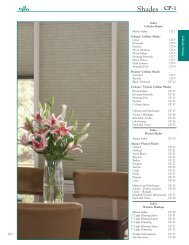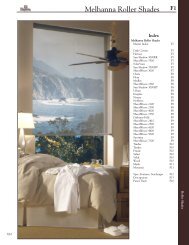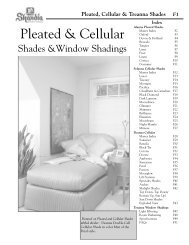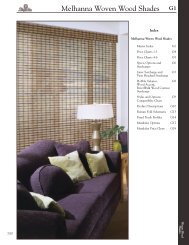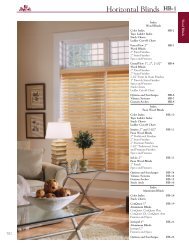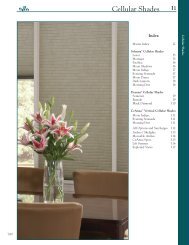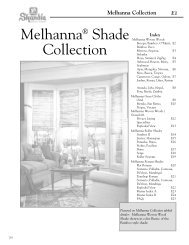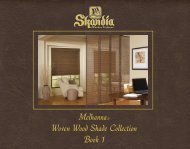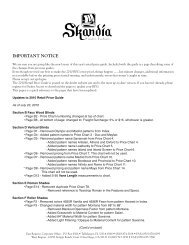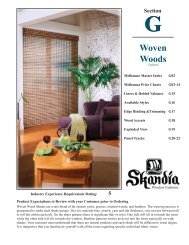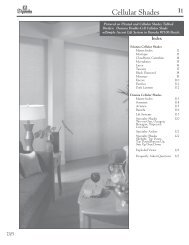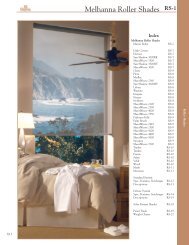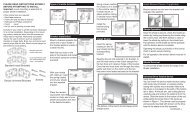Melhanna Collection - Skandia Window Fashions
Melhanna Collection - Skandia Window Fashions
Melhanna Collection - Skandia Window Fashions
Create successful ePaper yourself
Turn your PDF publications into a flip-book with our unique Google optimized e-Paper software.
7/04<br />
• Will the new roller shades match in color and texture<br />
to the ones you installed for me last month?<br />
When our suppliers paint, dye or extrude the<br />
materials we use to fabricate our products, there are slight<br />
coloration changes from each run. For example, when our<br />
wood finisher paints slats in our color pure white, the final<br />
color is affected by both temperature and humidity. If one<br />
run is produced when the temperature is 78º and the<br />
humidity is 60% and the next run is produced when the<br />
temperature is 82º and the humidity is 78%, the differences<br />
in temperature and humidity, will cause each run of<br />
pure white slats to vary slightly in color.<br />
• What is considered an acceptable tolerance for color or<br />
texture match?<br />
The commercial tolerance for an acceptable color or<br />
texture match is a 2-foot separation. If there is no discernible<br />
difference between two colors or textures when placed 2 feet<br />
apart, the difference is considered acceptable. The many factors<br />
that influence color and texture make it impossible to<br />
paint, dye or extrude materials that match perfectly from run<br />
to run. There will always be slight differences. However, our<br />
experience has shown that these differences are not significant<br />
and can only be seen if the materials are placed next to each<br />
other. Holding the materials 2 feet apart, you will not be able<br />
to see a discernible difference. This is the standard to which we<br />
hold our vendors. It should not be an issue as long as your customer<br />
orders all the window coverings for a single room at the<br />
same time.<br />
• Will my window covering discolor or fade?<br />
Discoloration is usually defined as a color that<br />
changes negatively and is generally used to describe a loss in a<br />
colors intensity or the yellowing<br />
of the color.<br />
Discoloration or fading<br />
can be caused by many<br />
factors including but not<br />
limited to the temperature<br />
and humidity of the<br />
home, chemical cleaning<br />
agents, long-term sun<br />
exposure, cigarette or cigar<br />
smoke, general cleanliness<br />
of the home and the age of the product. Even though we use<br />
the finest materials available, including the latest UV (ultraviolet)<br />
resistant finishes, a reasonable amount of discoloration<br />
over time is to be expected. The sun’s rays are very damaging<br />
to vinyl and fabric materials. Over time, you can expect the<br />
side of the product that faces the sun to become slightly faded<br />
and a yellow cast or tint may become apparent.<br />
<strong>Melhanna</strong> <strong>Collection</strong><br />
E57<br />
Frequently Asked Questions<br />
<strong>Melhanna</strong> Roman Shades<br />
• Will the new Roman shades match in color and texture<br />
to the ones you installed for me last month?<br />
When our suppliers paint, dye or extrude the<br />
materials we use to fabricate our products, there are slight<br />
coloration changes from each run. For example, when our<br />
wood finisher paints slats in our color pure white, the final<br />
color is affected by both temperature and humidity. If one<br />
run is produced when the temperature is 78º and the<br />
humidity is 60% and the next run is produced when the<br />
temperature is 82º and the humidity is 78%, these climate<br />
differences will cause each run of pure white slats to vary<br />
slightly in color.<br />
• What is Mottle?<br />
Mottle, also referred to as blotches, is a term used<br />
to describe a material’s inconsistent appearance in color or<br />
texture. Any light-filtering fabric held up to a light source<br />
will have some mottling. Cellular and pleated shades, freehang<br />
vertical fabrics and Treanna fabrics have a certain<br />
degree of mottling. These fabrics look uniform or solid<br />
when laid on a surface that allows no light to go through<br />
the fabric. Some sections of the fabric will be darker (lets<br />
less light in) while others will be lighter (more light comes<br />
through). The pattern is not regular, so one shade’s light<br />
and dark areas will not be the same from one shade to the<br />
next. This randomness is characteristic and is part of the<br />
beauty and warmth that fabric provides. If you find this<br />
objectionable, you may want to select a totally opaque<br />
window covering such as a wood blind or PVC vertical.<br />
• What is considered an acceptable tolerance for color or<br />
texture match?<br />
The commercial tolerance for an acceptable color or<br />
texture match is a 2-foot separation. If there is no discernible<br />
difference between two colors or textures when placed 2 feet<br />
apart, the difference is considered acceptable. The many factors<br />
that influence color and texture make it impossible to<br />
paint, dye or extrude materials that match perfectly from run<br />
to run. There will always be slight differences. However, our<br />
experience has shown that these differences are not significant<br />
and can only be seen if the materials are placed next to each<br />
other. Holding the materials 2 feet apart, you will not be able<br />
to see a discernible difference. This is the standard to which we<br />
hold our vendors. It should not be an issue as long as your customer<br />
orders all the window coverings for a single room at the<br />
same time.<br />
• Will my window covering discolor or fade?<br />
Discoloration is usually defined as a color that<br />
changes negatively and is generally used to describe a loss in a<br />
colors intensity or the yellowing of the color. Discoloration or



